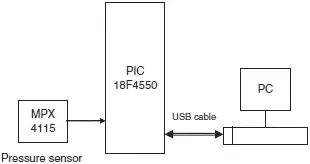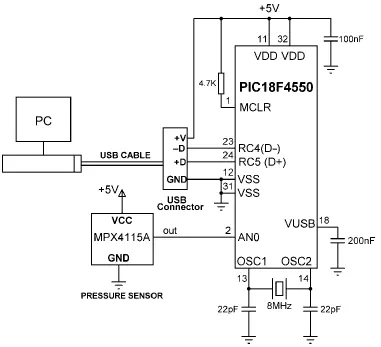The steps to calculate the pressure in millibars are:
• Read the output voltage of the pressure sensor using one of the A/D channels of the microcontroller
• Use Equation (8.4) to convert the voltage into pressure in millibars
The block diagram of the project is shown in Figure 8.36.

Figure 8.36: Block diagram of the project
The circuit diagram of the project is shown in Figure 8.37. The sensor output is connected to analog input AN0 of the microcontroller. As in Project 8.2, the USB connector is connected to port pins RC4 and RC5 and the microcontroller is operated from an 8MHz crystal.

Figure 8.37: Circuit diagram of the project
The program on the PC is based on Visual Basic, as in the previous projects. A single form is used, as shown in Figure 8.38, to display the pressure in millibars every second.

Figure 8.38: Visual Basic form to display pressure
The microcontroller program listing (named PRESSURE.C) of the project is given in Figure 8.39. At the beginning of the main program the PORTA pins are defined as analog inputs by clearing ADCON1 to 0 and setting port pins as inputs. Then the interrupt registers are set to their default power-on values. Timer interrupt TMR0 is set to generate an interrupt every 3.3ms to keep the USB bus alive. The USB port of the microcontroller is then enabled, and ADCON2 is initialized by setting the A/D clock frequency to Fosc/64.
/***************************************************************************
USB BASED ATMOSPHERIC PRESSURE DISPLAY ON PC
============================================
In this project a PIC18F4550 type microcontroller is connected
to a PC through the USB link.
In addition, a MPX4115A type pressure sensor IC is connected to analog port
AN0 of the microcontroller. The microcontroller reads the atmospheric
pressure and sends it to the PC every second. The PC displays the pressure
on the screen.
A Visual Basic program runs on the PC which reads the pressure from the USB
port and then displays it on a form.
The microcontroller is operated from a 8MHz crystal, but the CPU clock
frequency is increased to 48MHz. Also, the USB module operates with 48MHz.
The pressure is sent to the PC in millibars as a 4 digit integer number.
Author: Dogan Ibrahim
Date: September 2007
File: PRESSURE.C
****************************************************************************/
#include "C:\Program Files\Mikroelektronika\mikroC\Examples\EasyPic4\extra_examples\HIDlibrary\USBdsc.c"
unsigned char num,i,j;
unsigned long Vin, Pint;
unsigned char op[12], Pressure[4], Read_buffer[4];
float mV,V,Pmb;
//
// Timer interrupt service routine
//
void interrupt() {
HID_InterruptProc(); // Keep alive
TMR0L = 100; // Reload TMR0L
INTCON.TMR0IF = 0; // Re-enable TMR0 interrupts
}
//
// Start of MAIN program
//
void main() {
ADCON1 = 0; // Set inputs as analog, Ref=+5V
TRISA = 0xFF; // Set PORT A as inputs
//
// Set interrupt registers to power-on defaults
// Disable all interrupts
//
INTCON=0;
INTCON2=0xF5;
INTCON3=0xC0;
RCON.IPEN=0;
PIE1=0;
PIE2=0;
PIR1=0;
PIR2=0;
//
// Configure TIMER 0 for 3.3ms interrupts. Set prescaler to 256
// and load TMR0L to 156 so that the time interval for timer
// interrupts at 48MHz is 256*156*0.083 = 3.3ms
//
// The timer is in 8-bit mode by default
//
T0CON = 0x47; // Prescaler = 256
TMR0L = 100; // Timer count is 256-156 = 100
INTCON.TMR0IE = 1; // Enable T0IE
T0CON.TMR0ON = 1; // Turn Timer 0 ON
INTCON = 0xE0; // Enable interrupts
//
// Enable USB port
//
Hid_Enable(&Read_buffer, &Pressure);
Delay_ms(1000);
Delay_ms(1000);
//
// Configure A/D converter. AN0 is used in this project
//
ADCON2 = 0xA6; // A/D clock = Fosc/64, 8TAD
//
// Endless loop. Read pressure from the A/D converter,
// convert into millibars and send to the PC over the
// USB port every second
//
for(;;) // do forever
{
Vin = Adc_Read(0); // Read from channel 0 (AN0)
mV = (Vin * 5000.0) / 1024.0; // In mv=Vin x 5000/1024
V = mV / 1000.0; // Pressure in Volts
Pmb = (2.0*V + 0.95) / 0.009; // Pressure in mb
Pint = (int)Pmb; // As an integer number
LongToStr(Pint,op); // Convert to string in "op"
//
// Remove leading blanks
//
for(j=0; j<4; j++) Pressure[j]=' ';
j=0;
for(i=0;i<=11;i++) {
if(op[i] != ' ') // If a blank
{
Pressure[j]=op[i];
j++;
}
}
//
// Send pressure (in array Pressure) to the PC
//
Hid_Write(&Pressure,4); // Send to USB as 4 characters
Delay_ms(1000); // Wait 1 second
}
Hid_Disable();
}

Figure 8.39: Microcontroller program of the project
An endless loop is formed using a for statement. Inside this loop the pressure sensor data is read into variable Vin and then converted into physical voltage in millivolts and stored in variable mV . The atmospheric pressure is then calculated using Equation (8.4) and stored in variable Pint as a long integer. The mikroC function LongToStr converts this integer into a string in array op . Any leading spaces are removed from this array, and the resulting pressure is stored in a character array called Pressure . The mikroC USB function Hid_Write is then called to send the pressure data to the USB bus as 4-character data. The program then waits for one second, and the above process is repeated forever.
An 8MHz crystal is used to provide clock pulses to the microcontroller. The microcontroller CPU clock and the USB module are operated at 48MHz, and the clock and configuration register settings are as in the other projects in this chapter.
Читать дальше
















